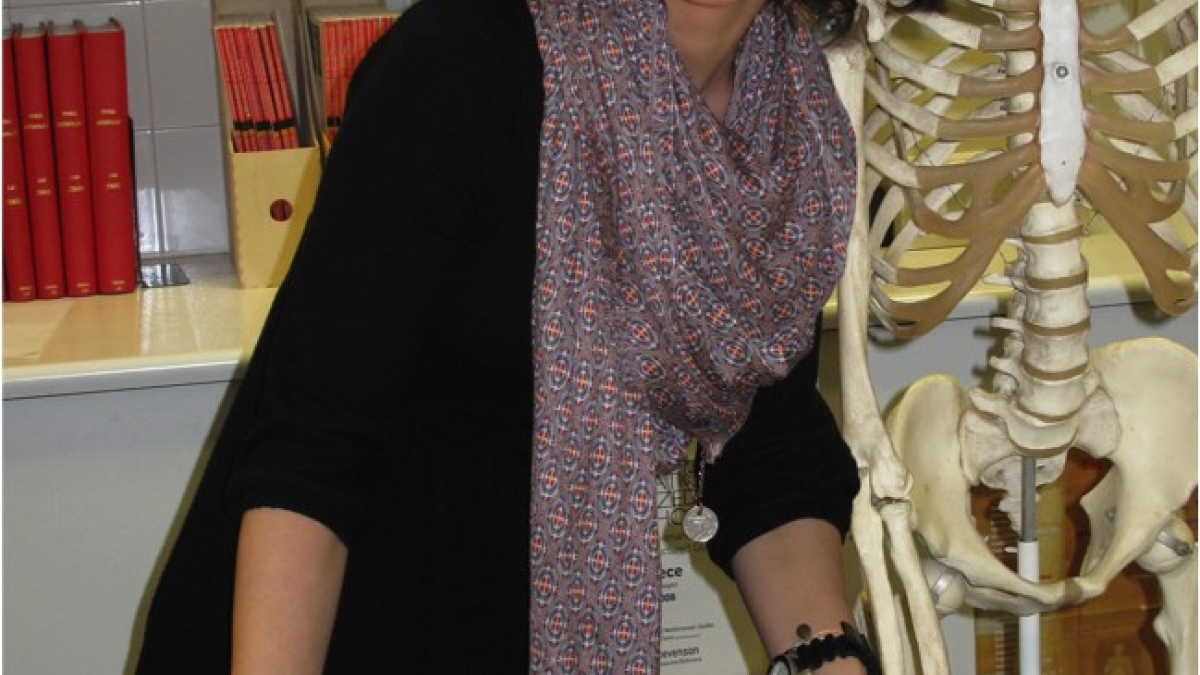Bringing the past to life: it's all Greek to bioarchaeology student

Eleanna Prevedorou was born and raised in the shadow of the Parthenon, within walking distance of the ruins of Plato’s Academy and the original Lyceum. As a native of Athens, Greece – the cradle of Western civilization – it seems natural that she gravitated toward the study of ancient peoples.
Off and on over the past decade, the Arizona State University bioarchaeology doctoral student has been investigating ancient human remains at the Wiener Laboratory of the American School of Classical Studies at Athens.
She recently returned to the Tempe campus after two years of data collection – one year sponsored by the lab, and one by the school as a whole.
The focus of Prevedorou’s efforts is a 5,000-year-old cemetery in Marathon, Greece, known as Tsepi. The Early Bronze Age graves contain multiple, successive burials, a common practice of the time. They compose the earliest burial complex on the mainland that exhibits marked, formal spatial organization.
More than 150 crates with human remains from Tsepi were transferred to the Wiener Laboratory for Prevedorou to clean, prepare and examine. About 40 skulls were repatriated from the Vienna Natural History Museum, where they had been since the early 1970s.
Prevedorou’s tasks ran the gamut, from moving crates to giving tours and presentations to visiting scholars and students. The most time-consuming work involved readying the bones for analysis and preservation.
The Institute for Aegean Prehistory provided her with a professional conservator for nine months to treat the skulls. But Prevedorou and student volunteers under her supervision cleaned the bulk of the material over several additional months.
“Every day that found me sitting among my piles of bones at the Wiener Lab was equally fulfilling,” Prevedorou says of her time spent at one of the Eastern Mediterranean’s premier research and curatorial facilities.
Ultimately, she recorded data, such as heritable cranial and dental morphological features, to establish whether or not graves represent families.
She hopes to use biogeochemical data to estimate the origins of those who were buried in Tsepi and link that information to insights into social networks and kinship, as well as migration and mobility patterns.
Back in the U.S.
Now that she has returned to Tempe, Prevedorou will continue her dissertation work involving the Tsepi burials.
Her chair is bioarchaeology pioneer and Regents’ Professor Jane Buikstra, who directs the Center for Bioarchaeological Research in the School of Human Evolution and Social Change in the College of Liberal Arts and Sciences.
Buikstra and the university’s burgeoning bioarchaeology program were the reasons Prevedorou chose to attend ASU.
“Bioarchaeology made it possible for me to bridge my archaeological background with biological and social sciences, while the program at ASU offered me a remarkably broad range of training in methods and theories relevant to the field,” she says. “Working with Jane and the other school faculty over the last few years has been a privilege.”
Prevedorou and Buikstra recently began a project revisiting human remains from an Early Bronze Age well deposit in Corinth. The assemblage, originally studied by J. Lawrence Angel, but not fully published, is housed at the Smithsonian Institution in Washington, D.C.
Buikstra is excited by the strength and implications of Prevedorou’s research.
“Her work symbolizes the ongoing integration of the humanities and the sciences in the study of the Classical World,” she says.
A long-time love
For Prevedorou, bioarchaeology is a long-standing interest, one she embraced long before she knew the name of the discipline.
She first remembers seeing a human skeleton around the age of seven. Her grandfather took her to a monastery built on the steep cliff of a gorge in the Peloponnese, near the ancestral home of her mother’s family. They visited a room filled with the skulls of priests and monks.
“I remember being scared but also utterly fascinated by the series of human crania placed on a rock shelf,” she explains. “I kept wondering where the rest of the bodies were. Where did the other bones go? That experience had a profound impact on me.”
Another life-changing moment for Prevedorou came almost 10 years ago, when she walked into the Wiener Laboratory looking for a copy of the American Journal of Physical Anthropology. The recent archaeology graduate from the University of Ioannina was warmly greeted by the director, Sherry Fox, who introduced her to the practices and concepts of bioarchaeology. Prevedorou spent the next two years volunteering at the lab, working with Fox on human skeletal material.
Though Tsepi is Prevedorou’s specialty, her interests are broad, and she plans to expand her research into other regions and eras to delineate patterns emerging from changes in human behavior throughout time.
One of her ongoing projects dates to the Early Christian Era, around the seventh century A.D. Prevedorou is exploring an assemblage deep inside a cave in southern Greece. The archaeological and biological evidence suggests the cave may have been used as a refuge by a group of people residing in the immediate vicinity. She looks forward to pursuing the data to discover greater understanding of the history – including conflicts – of long-ago peoples.
“Being able to conduct research in my homeland and study the people who lived there thousands of years ago and shared the same landscape is very moving,” she says. “Through the study of their physical remains I feel that the past becomes alive again and I can relate to it since this is a place I know so well. It gives me a new perspective on human time and the nuances of life experiences.”